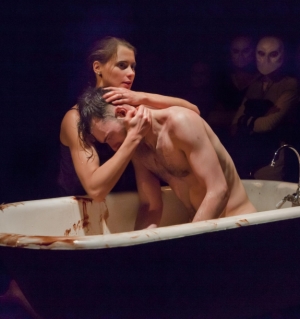 What lessons can cinematic immersion and theatrical masquerade teach us about the way we mourn? In this comparative analysis of Punchdrunk’s The Drowned Man and David Lynch’s Rabbits, I aim to find out how the experience of losing our loved ones inside a fantasy world can fundamentally affect the way we think and feel about them. In doing so, I hope to produce a critique towards the importance of community in the event of a loss, as well as an explication on how repairing lost contact can help us in even the most unexpected situations.
What lessons can cinematic immersion and theatrical masquerade teach us about the way we mourn? In this comparative analysis of Punchdrunk’s The Drowned Man and David Lynch’s Rabbits, I aim to find out how the experience of losing our loved ones inside a fantasy world can fundamentally affect the way we think and feel about them. In doing so, I hope to produce a critique towards the importance of community in the event of a loss, as well as an explication on how repairing lost contact can help us in even the most unexpected situations.
In Part 1, I looked at how ordinary family life and the role of masked spectatorship can intersect to produce unexpected feelings of loss. In The Drowned Man, the spectator wears a white, deindividuating mask not only to create a generic barrier between himself and the performance, but also to separate him from his loved ones for the show’s duration. This has the uncanny effect of blurring together the common lines of distinction between ‘family’ and ‘stranger.’ As a result, the narrative spectacle of the showcase itself works as a kind of mourning ritual. Isolated yet joined at the hip to the spectators around us, we work independently to reconvene our losses in a story we construct of our own accord. Although this ultimately allows us to come to terms with our separation anxieties, we are also left feeling more disconnected than ever, as we realise that our fantasies simply cannot accommodate every event in the showcase as it unfolds.
 Recently I had the pleasure of attending Punchdrunk’s hyped and much talked-about Hollywood promenade show The Drowned Man. In case you haven’t heard of it, the show is approximately the closest thing I would describe as a walking, or lucid, nightmare. It is also the closest I have come to the intimate recreation of a communal mourning rite.
Recently I had the pleasure of attending Punchdrunk’s hyped and much talked-about Hollywood promenade show The Drowned Man. In case you haven’t heard of it, the show is approximately the closest thing I would describe as a walking, or lucid, nightmare. It is also the closest I have come to the intimate recreation of a communal mourning rite. We are all born in closets. This truth, for many, is immutable. The absolute of the closet today is seen as a less of an obstacle of blatant inequality, and more and more a gauntlet of personal will – hardwood paneling – a self-imposed tomb only you can muster the courage to escape from.
We are all born in closets. This truth, for many, is immutable. The absolute of the closet today is seen as a less of an obstacle of blatant inequality, and more and more a gauntlet of personal will – hardwood paneling – a self-imposed tomb only you can muster the courage to escape from.
